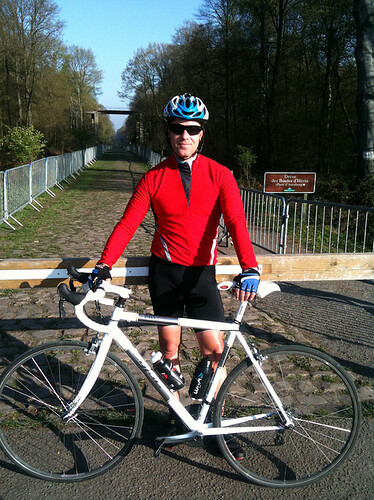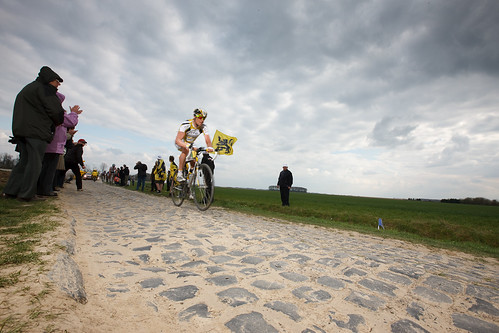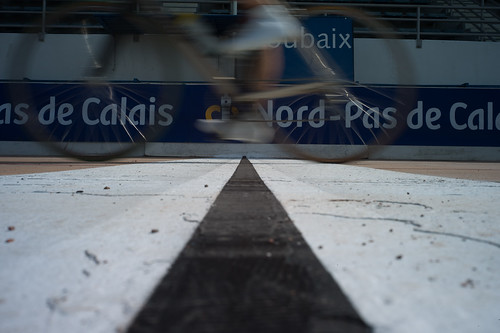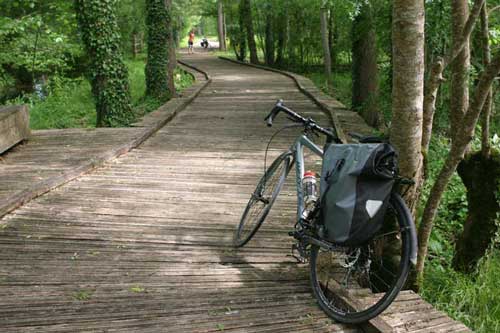It's billed as the 'Hell of the North', the most treacherous of the Spring Classics leading up to the Tour de France. Gerry Patterson rides the Paris-Roubaix cobbles to find out why.
Gerry prepares to take on the cobbles of the Paris-Roubaix at Arenberg. Photo: Pavé Cycling Classics
The cycling magazine on my kitchen table is titled ‘Voyage to the End of Hell’; the coffee table book I have sitting next to me is Journey Through Hell; the documentary I saw on the weekend? A Sunday in Hell. I’m sure I’d be seeing ‘Highway to Hell’, if AC/DC didn’t already have the rights to it.
Yes, I’m talking about Paris-Roubaix, one of the oldest one-day cycling races in the world and, nearly indisputably, the hardest and most terrible.
This is the story of my Weekend in Hell – my trip to the north of France to see what all this hype was all about.
My hosts for the weekend were Alex Voisine and William Lanigan, owners of Pavé Cycling Classics, a tour company specialising in the famous rides of northern France and Belgium; my companions for the weekend were a group of triathletes from London, a French guy living in San Francisco, and a journalist from Cycling Weekly.
Our first half-day was devoted to carbing up, riding a bit (over the border in Belgium) and drinking Pavé’s own organic Belgian beer. Beer is carbs, right?
The unforgiving cobbles of the Paris-Roubaix. Photo: tetedelacourse
Fast forward to Saturday morning and I am standing at the gated entrance of the Arenberg Trench, a 5-star section of cobbles 2.4 km long that will certainly go down in history as one of the most horrifying experiences I’ll ever have on a bike. And I’m not alone. Here is a short list of some of the carnage this trouée has seen in its 43-year history as part of Paris-Roubaix.
Crashes: at least 27, involving 90 riders, including Eddy Merckx (1972).
Flats: 20, including Stuart O’Grady, who went on to win anyway (2007)
Paralysing fear: 1 that I know of… (2011)
In 2011, three-time winner Tom Boonen had a mechanical in the Trench that put him far behind the rest of the favourites. He had more bad luck up the road, but Arenberg was the first nail in his coffin, and he abandoned the race somewhere down the road.
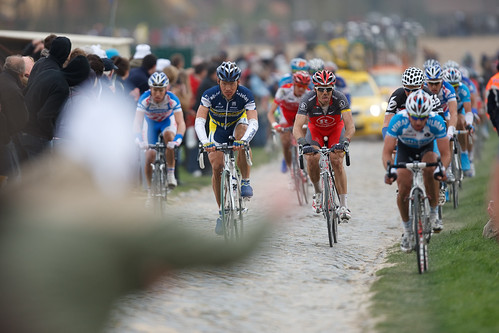
The pros show how it's done during the 2010 Paris-Roubaix. Photo: tetedelacourse
Alex joyously informs me how terrible it is going to be and then he’s off like a slingshot. As soon as I hit the cobbles I know I am in a whole new universe of pain. Going slow is impossible. You must attack the cobbles at full speed, so I gunned it for the whole length, straight down the middle, following the lead of my masochistic guide. It was like riding over a rolling earthquake on fast-forward. There must be some shock absorbed by the bike, but there was plenty left to attack my butt, wrists and brain. My helmet was bouncing around uncontrollably, my arms shaking like jackhammers, and my legs screaming with the force I was asking of them. It was really, really awful.
Really.
And it was long. I thought those 2,400 metres would never end for much of the way. Then, slowly, it dawned on me that I wouldn’t die probably, and that my eyeballs would stay in their sockets, and that actually this was kind of fun. There is a bit of the masochist in all of us, I suppose, and an evil rush overtook me. When I reached the end of the forest, Alex was waiting with his (what I would later learn) trademark evil grin. Only 14 more cobbled sections to go.
The cobbles up close and personal. Photo: tetedelacourse
The Paris-Roubaix Cobbles
Why does Paris-Roubaix have all these cobbled sections? At the time cycling races took off in the late 19th century (Paris-Roubaix was first run in 1896), most roads were cobbled, or simply dirt. The race probably wasn't much different from any other; it wasn’t until after WWI that mass modernisation took place, leaving lonely sections of cobbles in between long stretches of tarmac.
In fact, for the longest time, cobbles were seen as being associated with backwardness and the past, an association that the north of France didn’t really relish (wasn’t the race’s nickname, ‘Hell of the North’, bad enough..?), so mayors would pave over any remaining cobbles around their towns and the
pavé became harder and harder to find. By 1965 only 22km of the entire race (nearly 300km) were cobbled. A shift in perception happened in the sixties and with the discovery of the Arenberg Trench (among others), those evil sections of pavé would become an enduring symbol and a Paris-Roubaix without cobbles today would be unthinkable.
A Personal Hell
We rode section after section, usually with a short commentary by Alex before hitting the cobbles. It would usually go something like this, ‘OK, this next one is short, but really terrible’, or ‘this is long and difficult and always has a headwind’. And always that knowing grin that told you he was telling the truth.
One of the worst sections was, as he said, not long, but awful. This stretch of pavé is a testament to the new love organisers and locals show their cobbles. The Moulin de Vertain was only discovered in 2002. The road had been covered over by dirt for years and all but forgotten, but a certain Madame
Farine recalled that her mother used to tell her of a cobbled road nearby. Out came the diggers and, sure enough, a new, nasty section was born. It has big cobbles, sitting at all sorts of unnatural angles, jagged corners just waiting for you to puncture on them. It’s hard to believe that anyone would look at this and think it would be a good idea to walk on, let alone race over it on a road bike. But then again, there aren’t many exercises in agony quite like Roubaix. The Moulin de Vertain fits in just right.
The race ends in the vélodrome of Roubaix, but it's often decided on the section we finished our ride on: the Carrefour de l’Arbre. This sector is very hard, but is compounded by the fact that it is preceded by an equally odious section called Camphin-en-Pévèle, and you (well, the pros) hit it after more than 250km of full-tilt torture. After the Carrefour there are only 14.5km of easy roads to go, so drama often takes place here. This year was no exception, with Johan Vansummeren putting in an attack on his leading group on the Carrefour and distancing them enough to stay ahead until the stadium.
The 2010 Paris-Roubaix reaches the velodrome. Photo: tetedelacourse
Alex took us to the vélodrome, the hallowed arrivée that has greeted such greats as Coppi, Merckx, Kelly, De Vlaeminck, and Boonen, and whose equally sacred showers have soothed the pains of countless nameless riders who never even caught a whiff of the podium. It must be a good way to finish a day in Hell – a ritual cleansing of a battered soul. Alas, the showers were closed to us, so we had to go back to Pavé’s HQ and wash away our pain with Belgian beer.
So how was Hell? I suppose it depends on your idea of fun. If you’re a cyclist, you are most likely a sucker for pain, and a day out on the pavé of Paris-Roubaix would certainly qualify as a good ol’ suffer-fest. One of the beauties of being a cycling fan is that you too can ride the same famous roads and feel the same agony as your heroes – and nothing is more painful than the cobbles of the Hell of the North.
Pavé Cycling Classics runs organised Paris-Roubaix rides, as well as rides on the roads of Flanders. See the website for more details.
See also Gerry's tips for surviving a ride along the Paris-Roubaix route.
Paris-Roubaix on film
A Sunday in Hell, is a documentary by Jorgen Leth that follows the 1976 Paris-Roubaix. Featuring Merckx, De Vlaeminck, Martens and Moser, it is regarded as a masterpiece, possibly best cycling film ever made.
Road to Roubaix, a film by David Deal and Dave Cooper, is a more modern take on the race, and also worth a look.
Paris-Roubaix books
Paris-Roubaix: A Journey Through Hell by Phillippe Bouvet, Pierre Callewaert, Jean-Luc Gatellier and Serge Laget, a quartet of France's leading cycling writers, offers stunning coverage – in both words and pictures – of the race. There's also The Spring Classics: Cycling's Greatest One-day Races by the same authors, which features Paris-Roubaix as well as Milan-San Remo, Ghent-Wevelgem, the Tour of Flanders, the Amstel Gold Race, La Fleche Wallone, and Liege-Bastogne-Liege.
See also William Fotheringham's A Century of Cycling: The Classic Races and Legendary Champions. Fotheringham, who writes about cycling for the Guardian newspaper, is also the author of Put Me Back On My Bike, the acclaimed biography of Tom Simpson, Fallen Angel: The Passion of Fausto Coppi, and Roule Britannia: A History of Britons in the Tour de France. Most recently, he has written Cyclopedia: It's All About the Bike.
If you're planning on tackling the route yourself, see IGN's Lille-Roubaix-Tourcoing map. Michelin has a Northern France map and a Northern France and the Paris Region guide. There's also Bradt's Cross-Channel France: Nord-Pas de Calais – The Land Beyond the Ports by John Ruler, which includes a tourist overview of the town of town of Roubaix.
Gerry Patterson lives in Nîmes with his wife, Shoko. When not updating his cycling blog and adding routes to his website, he can be seen – you guessed it – cycling around Languedoc-Roussillon, searching out new and interesting rides.
See also Gerry's guide to themed rides in Languedoc-Roussillon, and his guides to Montpellier, Perpignan, Nîmes and Narbonne.

